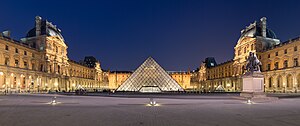Louvre Palace
| Louvre | |
|---|---|
| Palais du Louvre | |

Night view of the Louvre Pyramid in the centre of the Napoleon Courtyard of the Palais du Louvre
|
|
| General information | |
| Type | Royal residence |
| Architectural style | Additions of the 13th and 14th centuries: Gothic, Additions of the 16th century: Renaissance, Additions of the 17th and 18th centuries: Louis XIII Style and Baroque, Additions of the 19th century: Neo-Classicism, Neo-Baroque and Napoleon III Style, Additions of the 20th century: Modernism |
| Construction started | 1202 (Louvre Castle), 1546 (Louvre Palace) |
| Completed | 1989 (completed by the Louvre Pyramid) |
The Louvre Palace (French: Palais du Louvre, IPA: [palɛ dy luvʁ]) is a former royal palace located on the Right Bank of the Seine in Paris, between the Tuileries Gardens and the church of Saint-Germain l'Auxerrois. Originally a fortress built in the medieval period, it became a royal palace in the fourteenth century under Charles V and was used from time to time by the kings of France as their main Paris residence. Its present structure has evolved in stages since the 16th century. In 1793 part of the Louvre became a public museum, now the celebrated Musée du Louvre, which has expanded to occupy most of the building.
The present-day Louvre Palace is a vast complex of wings and pavilions on four main levels which, although it looks to be unified, is the result of many phases of building, modification, destruction and restoration. The Palace is situated in the right-bank of the River Seine between Rue de Rivoli to the north and the Quai François Mitterrand to the south. To the west is the Jardin des Tuileries and, to the east, the Rue de l'Amiral de Coligny, where its most architecturally famous façade, the Louvre Colonnade, and the Place du Louvre are found. The complex occupies about 40 hectares and forms two main quadrilaterals which enclose two large courtyards: the Cour Carrée ("Square Courtyard"), completed under Napoleon I, and the larger Cour Napoléon ("Napoleon Courtyard") with the Cour du Carrousel to its west, built under Napoleon III. The Cour Napoléon and Cour du Carrousel are separated by the street known as the Place du Carrousel.
...
Wikipedia
